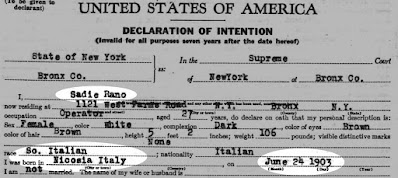It began with a 1900 ship manifest showing my relative, Giuseppe Caruso, on line one. I found this record very early in my family history research.
| My second great uncle and another man had the same brother-in-law. Hmmm. |
Giuseppe was my great grandmother's brother. I was looking for evidence that would lead to her ship manifest. This was a solid lead. It confirmed two facts: Giuseppe came from the town of Pescolamazza, Italy, and he was going to Elmira, New York. Those facts we enough to make me feel I had the right Giuseppe Caruso.
Before I filed the document away, I noticed the passenger on line two. Nicola Capozza was also from Pescolamazza. He was also going to Elmira, New York. But here's the curious part. Both Giuseppe and Nicola said they were joining their brother-in-law Michele Castelluzzo.
That's intriguing. I didn't know who Nicola Capozza was, but he and my great grandmother's brother shared a brother-in-law.
Skip ahead several years. I ordered the marriage certificate for my great grandparents from the state of Ohio. At that point I didn't know the maiden name of Maria Rosa's mother. This marriage certificate could be just what I needed!
 |
| What could I learn from the witnesses to my great grandparents' marriage? |
If you've been dabbling in genealogy a while, you know how often the clue you need the most is the one that's missing. That's the case with this marriage certificate.
My great grandfather's parents' names are there. But I knew their names already. For the parents of the bride, it says "Francesco de Benevento" for her father. Well, her name is Caruso, and they were from the province of Benevento, so someone mistakenly wrote "Francesco from Benevento". No harm done. It's her mother's name that's the problem. All it says is Maria Luigia. No last name!
Still fuming, I turned my attention to the back of the marriage certificate. The witnesses to my great grandparents' wedding were Nicola Cappocci and Nicoletta Cappocci. I figured they were a married couple who knew my family. I wanted to know more about them.
There was a chance Cappocci was a misspelling since these were not signatures. Several wild-card searches later, I determined Nicola Cappocci was Nicola Capozza who shared a brother-in-law with my second great uncle, Giuseppe Caruso.
I found Nicola and his wife Nicoletta in the 1905 New York census. They were living with Giuseppe Caruso and his family. Then I found a 1909 ship manifest with Nicola coming to Susquehanna, Pennsylvania. Giuseppe Caruso lived there at the time. But Nicola's wife Nicoletta was back in Pescolamazza.
Next I found Pescolamazza birth records for Nicola Capozza and Nicoletta Martino on the Antenati website. But I hadn't tied Nicola and Giuseppe to that shared that brother-in-law.
The connection—not surprisingly—came from all the intermarrying of families in small Italian towns in the those times.
Capozza was the key.
 |
| That the Capozza siblings' mother was also a Caruso is making my head spin. |
Nicola Capozza's sister Marianna married my Giuseppe Caruso. So Nicola and Giuseppe, travelling together in 1900, were brothers-in-law. There were eight Capozza siblings. One of the girls, Caterina Capozza, married—wait for it—Michele Castelluzzo.
Michele came to America around 1891 and lived in Elmira, New York. There was plenty of railroad work, so Michele sent for his brothers-in-law. His wife's brother Nicola came to work. His wife's sister Marianna's husband Giuseppe Caruso came to work.
Giuseppe Caruso brought over most of his siblings. It's a safe bet that Giuseppe met my great grandfather, Pasquale Iamarino, working there in the Elmira railyard. He liked Pasquale enough to suggest that he marry Maria Rosa Caruso, who was still in Italy.
In July 1906 Maria Rosa came to join her brother in Elmira. Four months later, she married Pasquale Iamarino.
Every piece of evidence adds to the rich tapestry of our ancestors' lives. When I first saw that name of the shared brother-in-law, I didn't know he was significant. But if Michele Castelluzzo hadn't gone to work for the railroad in Elmira, New York, my great grandparents would never have married.
In fact, if Giuseppe Caruso hadn't married a Capozza, the Caruso family and the Iamarino family may never have met.
You have to marvel at how much luck and happenstance it take for you to be born.








